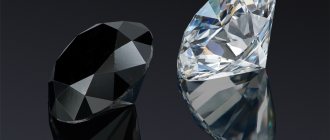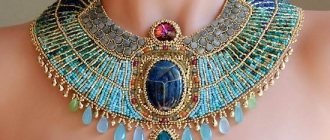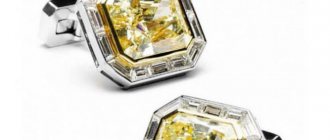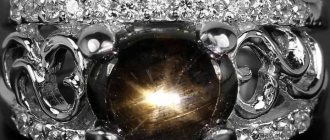The Vogue archive houses more than a million images, revealing the evolution of fashion and culture since the magazine's inception in 1917. For her new book, magazine editor Carol Woolton delved into a priceless collection of some of the world's most breathtaking illustrations. She is confident that these paintings “will be able to tell the story of jewelry making of the last century like no other.”
Advertising - Continued below
Vogue: The Jewelery
Vogue: The Jewelery by Carol Woolton (Octopus Books) is a hardcover book that explores the countless styles of jewelry that have emerged over the past century. Separate chapters are devoted to jewelry that adorned rock musicians, members of royal families, jazzmen, as well as immortal creations and avant-garde design.
The entire spectrum of jewelry, all its changes over time, are all captured by famous photographers and illustrators, and I am delighted that I was able to preserve it. Carol Woolton
Advertising - Continued below
Jewelry Art. Illustrated Guide to Jewelry
Not every book contains such excellent photographs; there are 919 of them and all of them are life-size. The famous company De Beers presented a unique cut of diamonds for illustrations. Experts from the famous Sotheby's auction house worked on the materials of the book, which is interesting for collectors, designers and specialists in the field of jewelry, as well as for history buffs.
Separate parts are devoted to periods ranging from the end of the 18th century to our time. With such a wide selection of designs and real family jewels, our great-grandmothers ordered less expensive copies and used antique jewelry with removable parts in their daily lives, right up to wartime.
Attention is paid to recommendations from professionals regarding special tools - microscopes, and quite easy-to-use pocket magnifiers, which help to become more familiar with the characteristics of stones and gems. It is possible that, upon closer examination, some of them will reveal a completely different nature, for example, a wonderful blue sapphire will turn out to be natural or artificial spinel.
The ancients attributed mystical properties to stones and revered them as some kind of living structures, the fact is that sometimes they can pretend to be something other than what is stated on the label, as if playing along with people’s games. It’s interesting to know what different colors a girl’s best friend, diamonds, come in. The names of some types of their cut - marquise, or heart - are full of romance and warmth; they are quite capable of becoming a declaration of love and a talisman bringing happiness and good luck. The masters drew ideas for their creations from the surrounding animal and plant world.
In the 1830s, special symbols, the language of flowers, secret codes and entire stories began to be used, which remained popular for at least 20 years. What kind of jewelry was fashionable to wear at what time and who created the fashion for jewelry - you can find out about this thanks to the jewelry directory.
Stoned: Jewelry, Obsession and How Desire Shapes the World
Woolton is not the only one who has been fascinated by the history of jewelry and its impact on the world. For the curious and those who want to look a little deeper, Aja Rodin's book "Stoned: Jewelry, Obsession and How Desire Shapes the World" (Harper Collins) is perfect. . Weaving together science and pop culture, this fascinating and insightful book attempts to answer the question of what makes gemstones so special and why we are so obsessed with their brilliance.
Advertising - Continued below
“Boucheron. Secret archive of the most famous jewelry house"
Author: Vincent Meylan
Back in 1858, a jewelry house was founded, immortalizing the name of the owner Frederic Boucheron. At first, the house was a small workshop, but in an elite area of Paris. The jeweler's ideas were so bright that the list of customers expanded every second, and in 1893 the house moved to the so-called Golden Triangle - Place Vendôme. With the growing love of customers, interesting stories, unexpected orders and proposals also happened... You can now read more about all this in the book “Boucheron”, based on the archives. The secret archive of the most famous jewelry house."
Rothschild Renaissance: Treasures from the Waddesdon Bequest
For lovers of the Renaissance, we can recommend two new publications dedicated exclusively to this era. Dora Thornton, in her book Rothschild Renaissance: Treasures from the Waddesdon Bequest, examines the treasures bequeathed to the British Museum.
Bejewelled Treasures: The Al Thani Collection
Anyone planning to visit the V&A exhibition must read Susan Strong's special edition collection, Bejewelled Treasures: The Al Thani Collection, which tells an eye-catching and breathtaking story Indian jewelry.
Advertising - Continued below
The Guy Ladrière Collection of Gems and Rings
The famous Parisian collection of Guy Ladrière, which contains unique artifacts from the Minoan period to jewelry of the 19th century, can now be admired in the pages of a new book by Diane Scaribrick, Claudia Wagner and John Boardman, The Guy Ladrière Collection of Gems and Rings. stones by Guy Ladrière, Philip Wilson Publishers).
Text of the book “The Shine and Poverty of Costume Jewelry. Everyday jewelry in Russia and the USSR, 1880–1980"
69. Homemade brooch. Photography, fabric, beads, glass beads, fragments of Czech jewelry. 1920s.
From the collection of M.V. Smirnova
In addition to beads, “Egyptian” brooches also began to be produced in Gablonets. The Neiger brothers were and are considered the undisputed leaders in this area, having established the production of wonderful jewelry that harmoniously combined very fine stamped filigree and unusual glass inserts of complex shapes. In addition to the “Egyptian”, the Niger brothers successfully developed the “oriental” style. One of the chapters in the book by S. Jargstorf “Baubles, Buttons and Beads” (The Heritage of Bohemia, Schiffer, 1993, S. 89) is devoted to the history of the Niger company. Unfortunately, this story was very short. After the First World War, under the leadership of Norbert Neiger and thanks to the undoubted talent of designer Max Neiger, the company quickly acquired an excellent reputation. However, its prosperity quickly ended when the Nazis came to power. The Nigers were Jews, and they had to flee to Czechoslovakia, but they could not escape there either. After the occupation of Czechoslovakia, they were arrested and died in Auschwitz in 1942. Max Neiger's brooches are quite easy to recognize, despite the lack of a hallmark. They are distinguished by the originality of their metal decor, unusually shaped glass inserts and particularly subtle transitions of enamel colors on individual elements of the jewelry. It would be very interesting to know how their products got to Russia. Perhaps in the same way that Madame Brik received her jewelry, or perhaps this story was much more complicated.
70. A.A. Akhmatova.
a. Portrait. Olga Della-Vos-Kardovskaya, 1914
b. Photograph, 1914 (?)
c. Drawing. A. Saryan, 1946
d. Drawing. L. Smorgon, 1964
No less intriguing was, probably, the fate of the extremely curious homemade brooch shown in Fig. 69. On a backing covered with rough canvas fabric, there is a photograph of the last imperial couple framed by beads, bugles and pink beads. All of these materials are typical of the 1920s. Particularly characteristic of this time are beads with “Egyptian” decor. It can be assumed that this brooch was made after the revolution by some Russian emigrant devoted to the monarchy.
In the letter quoted above, Lilya Brik calls her sister Elsa Triolet, the wife of the famous French writer Louis Aragon, Elya. At the beginning of their life together, there was not enough money, and Elsa made a living by making beads, using everything down to fragments of Metlakh tiles (V. Katanyan. Lilya Brik. Life. M., 2002). And she even made a necklace for Elsa Schiaparelli from aspirin tablets (I. Sirotkina. Foxtrot and fashion in Soviet Russia. UFO, no. 29). Elsa's ability to make beads out of nothing is reflected in Aragon's poem "Song to Elsa":
You sewed your own weekend outfits, You knew how to thread cheap beads, Everything went into action - scraps, shreds, all the colored fragments... I couldn’t believe my eyes when I saw them for the first time Ice crystals when you went to dance...
Not everyone’s life was as successful as L.Yu. Brick. Anna Andreevna Akhmatova, for example, did not live so freely. However, the love for beads, which arose in her early youth, when they were an indispensable attribute of a sophisticated toilet, accompanied her throughout her life. From her portraits and photographs, one can trace the evolution of fashion jewelry over at least half a century: a long chain in a portrait by Olga Della-Vos-Kardovskaya (1914), a rosary in a photograph of approximately the same time, short large beads in a drawing by A. Saryan (1946), a short string of black or white beads in portraits of recent years (ill. 70a, 70c, 70c and 70d).
It can be assumed that the rosary as a decoration in the 1914 photograph is directly related to the publication in the same year of Akhmatova’s poetry collection “The Rosary,” which immediately made her famous. Marina Ivanovna Tsvetaeva also gave her an amber rosary during their last meeting in June 1941: “According to the text of Ali, who wrote down everything from the words of Anna Andreevna in 1957, she said: “Marina Ivanovna was with me, here, in this very room , I was sitting here, in this very place where you are sitting now... Marina Ivanovna arrived in the morning, and we were not separated all day, we sat in this room all day, talking, reading and listening to poetry. Someone fed us, someone gave us tea, - M.I. gave me this” (A.A. gets up, takes out from a tiny shelf by the door dark, amber, it seems, beads, each bead is different and there are more between them something). “This is a rosary” (M. Belkina. Crossing of destinies. M., 1988).
71. Fragment of bead embroidery. 1840s
71a. Fragment of embroidery floss. 1940-50s
At the same time, both Akhmatova and Tsvetaeva perfectly understood the symbolic meaning and purpose of the rosary. At the same time, Komsomol girls who grew up in the godless Soviet state simply used them as beads. One can understand that this often offended people who grew up before the revolution: “I was wearing a colorful, bright blouse with puffy sleeves when I came to Mayakovsky the next day.
“Natinka the lantern, colorful and transparent,” Vladimir Vladimirovich rejoiced at my arrival. And suddenly he became all gloomy.
- What is this, Natinka?
Around my neck I wore a carved cypress rosary ending in a cross.
- What is this, Natinka?
I explained:
- These are beads, they are beautiful.
Vladimir Vladimirovich took the rosary from my neck and, tearing off the cross, put it on again.
“It’s possible,” he still remained gloomy” (N. Ryabova. Kyiv meetings // Contemporaries about Mayakovsky. M„1993).
The undesirability of the appearance of a cross even in the smallest details of Soviet reality is clearly illustrated by a comparison of two embroideries: beaded embroidery from the 1840s and floss made in the early 1950s (ill. 71, 71a). Apparently, the design for a wall rug, sold on the market in the 1950s, was copied from antique bead embroidery and reproduced by some craftsman. A comparison of both embroideries shows that they are completely identical - with the exception of one detail: on the ancient embroidery a cross on a chain on the girl’s chest is clearly visible, but on the Soviet-era embroidery it is missing; only the chain was left by the unknown “censor”.
Indeed, one can still find rosaries made of shells, glass, carved wood, and ceramics without a cross (ill. 72). Some of them are made very skillfully, while others are strung from glass beads, obtained, judging by their appearance, in an artisanal way. Unlike beads, individual grains in rosaries, as a rule, are not strung on a thread: for the purpose of greater strength, they are fastened with metal loops. Every ten grains are separated by either a larger bead or a bead of a different material. Typically, such rosaries converted into beads consist of 50 or 100 grains (the most suitable length for beads), although the range of lengths of real rosaries was much wider - from 10 to 150 grains (S.A. Trofimov. Rosary. M., 2001).
72. Rosary (from left to right).
Carved wood, metal. Length 72. Transcarpathia (?). First half of the 20th century (?)
Strumbus shells, metal, coral (?). Length 87. Transcarpathia (?). First half of the 20th century (?)
Ceramics, metal, mother of pearl. Length 80. First half of the 20th century. (?)
Handicraft glass, metal. Length 94 (?). First half of the 20th century (?)
73. Gold-plated chains with bells, clips with bakelite. 1930s (Soraya Feder. Necklaces. Paris, 2000, p. 55)
73a. Up. Necklace with Indian heads. Metal with non-reflective gold plated. At the bottom. Parure with heads of Turks. Metal with non-reflective gilding. 1940s. (Soraya Feder. Necklaces. Paris, 2000, p. 51)
73b. Vivien Leigh. Still from the film “Gone with the Wind.” 1939
At the same time, a completely different style of costume jewelry was coming into fashion in America. Its source was Hollywood and movie stars who appeared on screen wearing luxurious “jewelry.” The author of the latter was the jeweler Eugene Joseff, who became famous for his fake jewelry and even received the honorary “title” Joseph of Hollywood – Joseff of Hollywood. In particular, he is the author of the jewelry used in the films “Gone with the Wind,” “Ben Hur,” and “Breakfast at Tiffany’s.” His parures with the heads of lions, elephants, Turks, chains with bells, made from a combination of glass and an alloy that imitated gold, were truly magnificent (ill. 73, 73a, 73b). Joseph used a special “gold” coating that did not produce glare during filming and was called “Russian gilding.” Film actresses loved his jewelry so much that they began to appear in them not only in the studio, but also in their free time. Of course, this fashion was picked up by their many fans, and in 1937 Joseph was able to launch mass production of his jewelry, which began to be sold in large stores.
74. Brooch “Lobster”. Glass, metal. E. Schiaparelli. 1930s
74a. Necklace with insects. Rhodoid. E. Schiaparelli, 1938
Demand creates supply, so in the 1930s there were already about 20 fairly large companies selling costume jewelry in America. Some of them opened at the very beginning of the 20th century, producing cheap jewelry that copied real jewelry, some started their activities from scratch. The most enterprising fashion designers - Elsa Schiaparelli, Hattie Carnegie - came to the need to create designer, inexpensive jewelry to complement their models. Sometimes they bought them from other companies and produced them under their own brand, and sometimes they hired a jewelry designer who worked directly for them. Thus, in particular, the famous shocking jewelry of Schiaparelli arose: “lobster” brooches or a necklace, which was a transparent disk with images of various insects (ill. 74, 74a).
75. Brooch “Eagle”. Metal, enamel, glass. Trifari. 1940s
With less extravagant consumers, full parures of a more traditional design, including a necklace, brooch, bracelet and earrings, were more successful. Moreover, the latter were, as a rule, clips with screw locks. High-end costume jewelry was produced by the company Trifari, founded in 1918, which achieved fame under the leadership of Alfred Philip in the 1930s. Brooches from this company with swords and exotic animals are especially prized; they often used a combination of gold with artificial pearls and small rhinestones (ill. 75). Schreiner used especially rare types of glass and excellent rhinestones for its products.
The products of each company had their own distinctive features. For example, the design of Miriam Haskell brooches necessarily included an openwork back wall; Particularly interesting are her brooches in the form of plants and animals made of shiny rhinestones, sometimes with filigree. To create beads, this company often used handmade beads. There is an extensive literature on the issues of attribution and collecting Western European costume jewelry (see, for example: J. S. Carroll. Costume Jewelry. 2010; S. Feder. Necklaces. 2000; J. Miller. Jewelry. M., 2004).
In general, American costume jewelry was distinguished by its bright colors, exceptional variety and opulence of design. Soviet women, with rare exceptions, were, of course, very far from this fashion. Moreover, jewelry continued to be considered something alien to the appearance of the builder of a new society. It is characteristic that not a single woman, a deputy of the Supreme Council, whose portraits were published in the magazine “Rabotnitsa” in 1937 (No. 30), wears any jewelry, even the most modest. The only piece of jewelry to be found in this issue is a simple oval brooch pinned under the collar of L.A. the pig farmer. Shchetkina.
Many women at this time ended up in camps, and former fashionistas were forced to return to Lamanova’s idea - to make beads from bread crumbs. An excerpt from Ekaterina Sudakova’s memoirs “Steep Steps” describes the process of creating a costume for a camp theatrical production: “Dear Irma Hecker made me a sundress from some discarded old sheets, which she symbolically painted to resemble river algae. The bead necklace was very skillfully made by someone’s skillful hands from ration bread…” (https://lib.rin.ru/doc/i/4686p65.html). Another beads made from bread appear in the memoirs of N.E. Dobrynina “Through a century and a half” (Moscow, 2009). They were made by the thief Panya for the mother of the author of the memoirs, when they both ended up in the same cell at Lubyanka. Panya advised: “At home, paint them in whatever paint you want: either red or blue. It will be beautiful!” Let us note that there was always a shortage of bread in the camp, but the craving for beauty conquered everything, and, according to knowledgeable people, the craftsmen were given the required amount of bread in excess of the norm.
In general, the tradition of making all sorts of trinkets by prisoners was not born in the Gulag. In the memoirs of Maria Alexandrovna Patkul, who traveled through Siberia in the second half of the 19th century, it is reported that “in the Iletsk prison, prisoners very skillfully make various small things out of salt.” From there she, in particular, “brought beads to Empress Maria Feodorovna...” (Moscow, 2014, p. 274). In other prisons, various decorations from hair have long been woven.
From bread crumb to Yablonex
“Come on, honey!
It’s not the neck that makes a woman, it’s the beads…” E. Belodubrovsky. "Coat, or Three Em", chapter 6.
By the early 1940s, a new paramilitary style had finally taken shape: formal suits with an accentuated waist and straight skirts, tight dresses with large padded shoulders, small hats and hairstyles with a perm and a high roller over the forehead. The long beads and earrings of the 1920s did not go well with this look. Beads around the neck, small clips, a small brooch under the collar, a modest buckle on the belt... (ill. 76). These unpretentious accessories were provided to Soviet women by small factories and workshops, and they were distributed through the Rosgalantereytorg system of stores (ill. 77).
On June 22, 1941, the Great Patriotic War began. The history of simple black plastic beads is associated with this date (Fig. 78). It was told by our neighbor Tatyana Georgievna Mirchink. The beads belonged to Tatyana Georgievna’s mother, Maria Evgenievna Mirchink (1887–1978), née Zalesskaya, who came from the Musin-Pushkin family. Even before the revolution, she married the outstanding geologist Georgy Fedorovich Mirchinok. They had three children, the husband worked at the Institute of Geology of the USSR Academy of Sciences. In the summer of 1941, the children lived with someone at the dacha, and Maria Evgenievna and her husband remained in Moscow. On the day that war was declared, Georgy Fedorovich went to his dacha in great excitement and soon returned to Moscow. The next day, as always, I went to work, but suddenly returned. When his wife asked him why he came back, he replied: “To kiss you.” He was arrested on the same day right at work. In October, when the Germans came very close to Moscow, they transported him to Saratov prison, where he died. Since then, Tatyana Georgievna’s mother, if she wore beads, was only these black ones, which remained a sign of mourning just as in the time of Queen Victoria.
76. Fashionable dresses and jewelry (Models of the season, Gizlegprom, M., 1941, No. 1, p. 29)
77. Advertising (Models of the season, Gizlegprom, M., 1941, No. 1, last page of the cover)
78. Beads. Plastic. Length 46. Russia (?). First third of the twentieth century.
During the war, fashion magazines, with rare exceptions, were not published, but “Peasant Woman” and “Rabotnitsa” continued their lives, all of whose topics were in one way or another devoted to the front. For example, in the story “Monisto” (Worker, No. 34), the old gypsy Mariula, who had kept a monisto of silver and several gold coins as a keepsake of her first love all her life, decides to give it to the needs of the front.
In the photographs in the magazines, the jewelry was also, of course, absent. They were discovered only in a photograph of the famous calf Grusha (Peasant Woman, No. 8, 1942). These were long pearl beads, beloved by everyone before the war, most likely hidden for the time being in the hair and worn on a special occasion. In the photograph, dated 1943 and intended for a beloved friend, the girl also apparently took advantage of the family chest and appeared in a magnificent folk costume with two rows of long beads, which came into fashion back in the 1920s (ill. 79, 79a).
Beads flashed once in the magazine “Crocodile” (No. 25, 1945). The artist depicted them on the secretary in Goebbels' office. Obviously, among Soviet satirists, jewelry was strongly associated with the most negative characters.
79, 79a. Girl in national costume, 1943. From the collection of V.P. Golitsyna
On the contrary, beads are a symbol of vitality in the 1941 poem “London” by the “Soviet European” I. Ehrenburg:
Houses are falling, and the day is sad Among the ugly ruins of others. But the living come out of the cracks, When they meet, they talk about the weather, They remove garbage from the sidewalks, They buy a mirror and beads.
The asceticism of the first years of the war began to gradually recede when, having found themselves in the West, our military began sending parcels to their homeland, which included jewelry. And at the end of the war they were brought from Germany in suitcases. In the book by L.M. Gurchenko’s “My Adult Childhood” (chapter “Dad Has Returned”) very vividly describes the scene of his father’s return from the war.
80. Garnet jewelry. Silver frame.
Czechoslovakia or Austria-Hungary.
The end of the 19th – the beginning of the 20th centuries.
Brooch "star". Diameter 4.3
Barrette. Dimensions 2x5.7
Earrings. Diameter 2.5
Necklace. Sliding cylindrical lock with safety lock. Length 41.
81. Girl with a brooch. Czechoslovakia, 1945. From the collection of V.P. Golitsyna
He brings a “chic” dress to his beloved daughter: “To see this dress, you have to imagine a peacock’s tail, not made of feathers, but of beads and iridescent stones. This is what it looked like from behind. And in front the dress was shorter, and garlands of beads hung like on a lampshade. And to go with this dress are green satin shoes with high thin heels.” Mark Gavrilovich also took care of his wife: ““– Lyalyusha! I haven’t forgotten about you either,” and threw the bag to mom. Wow! She has a big bag...
We heard my mother quietly purring something in the next room. Mom rarely sang. Her hearing was poor, and she was afraid of our ridicule. She hummed “Autumn,” and her singing felt special, her own joy and mystery. Dad and I looked at each other - somehow we forgot about mom - and went in to see her. She turned around in fear and looked questioningly at dad.
82. Girl with a brooch. 1940-1950s From the collection of V.P. Golitsyna
82a. Vera Deeva. 1949
She was wearing a red woolen dress, all in intricate ruffles, with shoulders, large amber beads on her neck, and a black and brown fox on her shoulders - the ultimate dream of every woman at that time. Mom was holding a brown crocodile bag in her hands.”
State jewelry stores sold relatively expensive items from reparations (in particular, large quantities of Bohemian garnets) (ill. 80), and costume jewelry was distributed privately.
Thus, for the first time after the revolution, Soviet women had a certain amount of jewelry made abroad. A photograph of a girl in a modest dress, pinned with a small brooch, was taken in Czechoslovakia (ill. 81). On the back is the inscription “10.05.45.
Czechoslovakia, Moravska Ostrava. Probably, this Russian girl went abroad for the first time in her life and hastened to decorate herself by buying or exchanging a foreign brooch. A brooch, most likely of the same origin, can be seen in a photograph of the late 1940s taken in Russia (ill. 82). Perhaps the openwork ivory brooch with the image of two deer and typically German or Austrian decoration came to us through the same route (see ill. 110a on p. 133).
Necklaces and brooches made of rhinestones in metal frames enjoyed particular success in the 1940s.
83. Jewelry from the 1940s - early 1950s. Germany (?) (top to bottom)
Beads "pearls". Glass. Sliding lock. Length 42.
The beads are black. Glass. Length 44. Round carabiner lock
Necklace. Glass, metal. Length 42. Rectangular carabiner lock
Black necklace with chain. Glass, metal. Length 42. Round carabiner lock
Pearl beads with rondels. Glass, metal. Round carabiner lock. Length 44
Brooch. Glass, metal. 5.5×2.5
Photo of a young woman. 1940s
84. White “roses” beads. Glass, beads. 5 threads. Hook lock with extension. Short thread length 37. Czechoslovakia. 1950s
Braid beads. Glass. Cylinder lock, metal, caps. Length 62. Czechoslovakia (?). 1940-1950s
84a and 84b. Model from the magazine “Riga Fashions” (1952/53, p. 9)
Necklaces, as a rule, included a central part and a chain, which consisted of rectangular links held together by movable joints. Ladies also liked metal brooches, either studded with small rhinestones or with a large faceted “stone” in the middle (ill. 83). Beads made of faux pearls or cut black glass and rondels with rhinestones, brooches and necklaces with rhinestones perfectly suited the look of a woman of the 1940s. A tight dress or suit with large padded shoulders, a black and brown fox with a muzzle, glass eyes and paws with claws, went perfectly with sparkling beads or a necklace.
85.
Braided beads. Beads. Sliding lock, decorated with beads. Short side length 39. France, 1940s.
Braid beads. Beads. Round carabiner lock. Length 41.
Czechoslovakia. 1940-1950s
85a and 85b. Young woman with a strand of beads and a brooch. Voronezh, 1949.
Along with imitation of transparent stones, opaque white glass and white enamel on a metal base were widely used in jewelry design (ill. 84, 84a, 84b). They also wore short twisted beaded plaits or thick beaded braids (ill. 85, 85a, 85b).
Obviously, in the first post-war years, not only the most fashionable jewelry came to Russia, but also products from the first third of the 20th century. Perhaps this is precisely why some of our grandmothers have necklaces, brooches, and beads that are clearly of Western origin, which are difficult to date other than the 1920s and 1930s.
86. Jewelry from the Baltics.
Brooch "sakta". Silver. Diameter 5.5. Latvia. 1940-1950s
Beads. Tree. Length 40. Latvia (?). 1930-1940s
Chain. Plastic, metal. Round carabiner lock. Length 44.
Latvia or Czechoslovakia. 1930-1940s
V.M. Mirimova. Late 1940s
In addition to defeated Germany, the newly-found Baltic republics were also a source of decoration. In 1946–1948, there were still small private workshops there, and at the flea market you could buy some of the previous stocks. For example, a chain of metal and plastic rings and wooden beads with flowers were purchased by my mother in 1947 at a market in Riga. Somewhat later, silver “sakta” brooches with images of folk dances, sailboats, or geometric patterns began to be brought from there (ill. 86). These brooches apparently appear in a picture from the then wildly successful magazine Rigas modes (ill. 86a).
86a. Models from the magazine “Riga Fashions” (1952/3, p. 2)
Almost immediately after the end of the war, an amber factory began operating in Kaliningrad. Amber jewelry began to appear in large quantities. The first swallows were carefully turned amber beads and brooches in the form of naturalistically executed flowers and berries. A classic example is the “Cherry” brooch with carefully cut leaves and berries from pressed amber tinted red (ill. 87 and 87a). They also produced simple oval brooches in a metal frame, as well as brooches made from a piece of natural amber with insects masterfully carved inside (unlike insects that got there naturally, they were very light), lizards and even ships (ill. 88, 88a).
87. Brooches “Bells” and “Cherry”. 3.5x2.5 and 3.5x5.5.
Amber, metal. Kaliningrad Amber Factory. 1940-1950s
Brooch "Flower". Amber, metal. Homemade. 1950s
From the collection of D.V. Demyanchik
87a. Nelya Zvyagintseva, 1956. From the collection of D.V. Demyanchik
Expensive foreign jewelry was not available to everyone. The deficit was filled by various artels, underground craftsmen, and speculators. The plant continued to operate in the village of Kostino, Dmitrovsky district (see p. 95 ill. 66). However, not all beads made in Russia can be identified as his products (Fig. 89). They vary greatly in style: some, combining cheap glass beads with metal elements, are an imitation of expensive Venetian beads, while others have a very simple design - alternating white glass and red plastic beads. Another bead could have been made at some electrical plant, since it consists of metal washers and ceramic beads similar to insulators. Apparently, only the beads shown in the center of the illustration were produced in series, since they are found quite often with glass of various colors. It has not yet been possible to specifically establish the release date of these decorations.
88. Amber jewelry. Kaliningrad. 1940-1950s
Beads. Amber. Plastic screw lock (?). Length 43
Brooch. Amber, metal. Oval 2.7x4.5
Brooch. Amber, metal. Oval 2.5x5
Brooch. Amber, metal. Oval 2.5x3. Homemade. 1950s
From the collection of L.I. Trofimova
88a. Brooch "Lizard". Dimensions 4x5.2. Kaliningrad. 1953–1954
Marina Aleksandrovna Kazankova, associate professor of the Chemistry Department of Moscow State University, spoke about the existence of small artels for the production of costume jewelry in the first post-war years. Her aunt, Anna Timofeevna Zhadina, worked as a stamper in the Metalloshtamp artel in Malakhovka from 1945 to 1946. There she inserted glass blanks into metal ring frames using a special 86a machine.
Models from the magazine “Riga Fashions” (1952/3, p. 2) folded the legs securing them.
89. Beads with pendant. Glass, metal. Crochet lock. 1960-1970s (?)
Beads. Ceramics, metal. Metal screw lock. 53. 1930-1950s (?)
The beads are fake Venetian ones. Glass, metal. Length 107. 1960s. (?)
Beads. White glass, red plastic. Length 70. 1940s. (?)
Sometimes she took work home, and little Marina watched with pleasure how quickly her work went. Anna Timofeevna's husband was listed as missing. In 1947, it turned out that he had in fact been shot, and his entire family was deported somewhere to Kazakhstan within twenty-four hours...
The story by M. Tarkovskaya “Spider Brooch” (Fragments of a Mirror. M., 2006) contains an interesting episode dating back to the post-war period. Neighbor Lenka comes to the mother of Andrei and Marina Tarkovsky and asks for a loan of 25 rubles. Having received the money, she appears fifteen minutes later and explains that a speculator she knew came and brought various brooches, from which Lenka chose “a terrifying-looking copper spider with long curved legs and a huge red piece of glass instead of a belly.” The author of the story explains that such brooches were very fashionable back then. The popularity of "spider beetles" was apparently very great indeed. In the memoirs of E. Belodubrovsky (“Coat, or Three Em,” chapter 6) it is reported that his Aunt Lyuba, a fashionista and beauty, has “a whole collection of brooches on a marble table... Mostly beetles...”. In the West, they came into fashion back in the 1930s and were considered prominent representatives of the Art Deco style (see p. 90 ill. 60).
90. “Butterflies” and “basket”.
Czechoslovakia (?). XX century
Fragment of a butterfly buckle. Glass, metal. 4.2×3.0
Brooch “Lacy Butterfly”. Metal, glass. Lock with safety lock. 3.5×5
Brooch "Blue Butterfly".
Glass, enamel, metal. Lock with safety lock. 4.4×5.2
Brooch "Butterfly". Metal, glass, mother of pearl. Pin lock. 2.5×4.2
Brooch “Basket”. Metal, glass.
Lock with safety lock. 3.5x4
Another eternal theme in costume jewelry was “butterflies” and “baskets”. For at least a hundred years they enjoyed constant success among the female half of the population (ill. 90).
Of course, everyone's favorite pearls were not forgotten. A string of pearls (fake or real) was still an integral part of every self-respecting lady. Short pearl beads adorn, for example, a young, cheerful girl in a photograph from 1957 (ill. 90b and 90c). And here is a wonderful excerpt from Irina Nisina’s story “Aunt Ritochka and Uncle Borusik,” published in the magazine “Sides of the World” (1957, No. 6): “For Ritochka’s fortieth birthday, Boris bought her a pearl necklace. Large snow-white pearls, of course, had to show off on black panne velvet. Rita immediately ordered a black velvet dress, and while waiting for the dress, she decided to figure out how the pearls looked. Rita put several rows of beads on a black cat. She did not admire Barsik for long. The cat jumped out the window and returned only in the evening, of course, without the pearls. Rita did not tell Boris about the loss for several months, she was afraid that he would kill Barsik... Rita and Boris died in the same year. Boris, saying goodbye to Rita, put on her his favorite pearl beads, which he bought a year after the first ones disappeared.”
90b and 90c. Girl with beads around her neck. 1957
91 and 91a. Beauty with clips and a brooch or necklace. 1951
From the collection of V.P. Golitsyna
The transition to shorter beads provoked the emergence of a new type of lock with an extension and a hook, which made it possible to adjust the length of the beads to the size of the neck. The clips became very small: from one shiny stone surrounded by rhinestones; in the form of metal leaves or small flowers made of cut glass. It is precisely these clips that can be seen in the photograph of the beautiful Svetlana, which she gave to a certain Arnold in 1951 with a meaningful inscription: “Love jokingly, but do not love jokingly” (ill. 91 and 91a). Sets (demi-parures) made of beads or necklaces and corresponding clips or brooches and earrings began to come into fashion.
92. Caricature. Magazine "Crocodile", No. 5, 1945, p. 8
93. "With all severity." Magazine "Crocodile", No. 20, 1952, p. 14
93a. Brooch. Glass, metal. Oval 2.2x3.5. On the back is the stamp “Moscow” and a five-pointed star with diverging rays. 1930s From the collection of V.P. Golitsyn.
Brooches. Glass, metal. Parallelepipeds 1.1x4; rhombuses 1.7x5. 1940-1950s From the collection of V.P. Golitsyn.
With the onset of peacetime, the attitude of ideologists towards jewelry did not change. The cartoonist of "Crocodile" (No. 5, 1945) still uses them as a negative characteristic. In the caricature, the boss’s promotion is accompanied by a clear “moral degeneration” of the secretary - from an amiable woman in a formal suit without any jewelry, she gradually turns into an arrogant woman lounging on a chair with a fashionable hairstyle and, of course, wearing earrings and beads (ill. 92).
The cover of the Krokodil magazine for 1952 is very characteristic: “positive” women are dressed modestly, they have no jewelry. Negative characters, as a rule, are marked either with beads or earrings: beads adorn frivolous ladies, overly caring mothers, wives of bosses, and earrings in the form of exaggerated rings are put into the ears of dishonest barmaids. Depicting a malicious violator of labor discipline in the cartoon “With All Severity” (Crocodile, No. 20, 1952), the artist included both beads and a brooch in her outfit (ill. 93).
Fabergé Eggs by Victor Mayer
Anna-Barbara Kerm, in her book “Fabergé Eggs by Victor Mayer”, Arnoldsche, in turn, focused on the work of the German company Victor Meyer, which from 1989 to 2009 owned the rights to create one of the the most iconic works of art: the Faberge eggs.
Advertising - Continued below
Gold
The enchanting shine of gold illuminates the entire history of human civilization. It has always been and remains a symbol of beauty, wealth and power. The ancient Egyptians called gold the chariot of the Sun, the Incas - then the Sun, the Persians - the seed of the gods.
Indeed, many peoples associate the bright shine and color of gold with the Sun, the divine luminary. On the other hand, gold is a metal that is rarely found and therefore evokes a passionate desire to own it. In the name of gold, empires were created and destroyed, wars were launched.
How to talk about the passions kindled by the shine of this metal, how to describe and explain the phenomenon of the gold rush? Gold, with its mystical radiance, illuminates the history of human civilization. And today gold has not lost its power: more than ever, it is a guarantee of the future - it is a talisman that can protect against harm, because deep down in the soul, modern man retains an irrational attachment to this almighty yellow idol.
Gold is the metal of kings and the king of metals. Gold symbolizes the amazing art of ancient peoples, but it does not lose its meaning today.
The myth of the Golden Fleece, the legend of El Dorado, the treasures of the pharaohs, the gold rush, alchemists, pirates and gold miners - the reader will find on the pages of this book a fascinating history of gold from the first archaeological finds to the use of this noble metal in the 21st century. The book is illustrated with color photographs.
Precious Statements
British jeweler John Donald, Princess Margaret's favorite designer, took an autobiographical approach to writing Precious Statements (McNidder & Grace). He and co-author Russell Castleton Elliott complemented their in-depth analysis of contemporary design with images of Donald's most innovative work.









